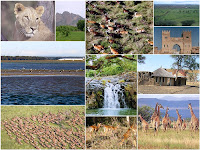Rwenzori Ice Cap Splits
 What a disheartening news: it has just been reported that due to global warming, the ice cap on the Ruwenzori has split. THE remaining ice cap on Mountain Rwenzori covering Margherita, the second highest peak in Africa, has split, creating a crevasse of 6 metres, according to the Uganda Wildlife Authority (UWA). Rwenzori has about six peaks but Margherita is its highest and most popular the world over. It provides a unique experience to mountain climbers. The peak was declared a world heritage site by UNESCO and it was recently gazetted as a Ramsar site requiring protection.
What a disheartening news: it has just been reported that due to global warming, the ice cap on the Ruwenzori has split. THE remaining ice cap on Mountain Rwenzori covering Margherita, the second highest peak in Africa, has split, creating a crevasse of 6 metres, according to the Uganda Wildlife Authority (UWA). Rwenzori has about six peaks but Margherita is its highest and most popular the world over. It provides a unique experience to mountain climbers. The peak was declared a world heritage site by UNESCO and it was recently gazetted as a Ramsar site requiring protection.More on the disaster:
The ice cap on Uganda's highest peak has split because of global warming, Uganda's Wildlife Authority (UWA) says.
The glacier is located at an altitude of 5,109m (16,763ft) in the Rwenzori mountain range, near the border with the Democratic Republic of Congo. The BBC
Ugandan wildlife authorities say the ice cap on the country's western Rwenzori mountain range has split after extensive melting caused by global warming. The Washington PostThe Ruwenzori ice caps covered more than 6 sq. km. 50 years ago; now it covers about 1 sq. km. - the ice, scientists say, could disappear in 20 years. From the Uganda Wildlife Authority: the 120km Rwenzori chain is regarded to be the legendary snow-capped Mountains of the Moon, described by Ptolemy in AD150. Reaching an elevation of 5,109m, it is also Africa's tallest mountain range, exceeded in altitude only by the free-standing Mount Kenya and Kilimanjaro. The distinctive glacial peaks are visible for miles around, but the slopes above 1,600m are the preserve of hikers, who rate the Rwenzoris to be the most challenging of all African mountains.


